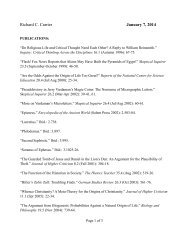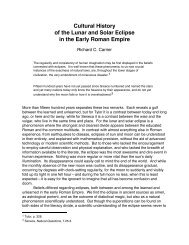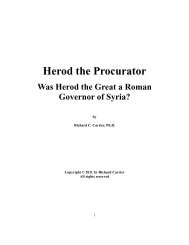“Bayes' Theorem for Beginners: Formal Logic and ... - Richard Carrier
“Bayes' Theorem for Beginners: Formal Logic and ... - Richard Carrier
“Bayes' Theorem for Beginners: Formal Logic and ... - Richard Carrier
Create successful ePaper yourself
Turn your PDF publications into a flip-book with our unique Google optimized e-Paper software.
30<br />
P(ate) + P(lied) = 1<br />
7. An easy way to think about this is to draw pie charts. The pie (the circle) represents the<br />
total probability space (all 100%, i.e. there is a 100% chance that the evidence we have is<br />
explained by something occupying space in that pie). So we carve it up to represent the<br />
relative likelihood of different explanations, based on what we know to be typical.<br />
8. For example, suppose we think that when students claim dogs at their homework,<br />
typically they are lying, but you would grant that’s not always the case. Maybe<br />
occasionally such a story really is true. We could model this judgment by saying the<br />
number of claims of dogs eating homework that are actually true is only 1 in 10 (don’t<br />
worry <strong>for</strong> now why we should settle on that number—we’re just ballparking it this time,<br />
we’ll get to the problem of determining numbers later). So only a tenth of the pie is<br />
devoted to that, while the rest, or 90%, is then occupied by students lying.<br />
9. That makes <strong>for</strong> a prior probability of:<br />
P(h|b) = 0.10<br />
<strong>and</strong><br />
P(~h|b) = 0.90<br />
Since P(h|b) + P(~h|b) must = 1, <strong>and</strong> 0.10 + 0.90 = 1.00, we can see that with these<br />
numbers we’ll have a valid Bayesian equation.<br />
10. If your background knowledge was such that you had more trust in your students, or<br />
there was a genuinely well-documented plague of dogs suddenly eating homework, or<br />
this particular student you know to be so honest you would actually be surprised if she<br />
were lying, even about dogs eating her homework, then you would divide the pie<br />
differently. If you had more trust in general student honestly, but were still skeptical of<br />
this sort of claim, you might say 1 in 4 claims of dogs eating homework are true, in which<br />
case P(h|b) = 0.25 <strong>and</strong> P(~h|b) = 0.75. In the last case, if you would be genuinely<br />
surprised, then the odds flip all the way over, e.g. P(h|b) = 0.80 <strong>and</strong> P(~h|b) = 0.20 (i.e.<br />
the claim being true is then initially a lot more likely, instead of the other way around).<br />
11. Ideally, you would work from perfect knowledge (you would have a completely<br />
reliable database of all dog-ate-my-homework claims <strong>and</strong> whether they were true or<br />
false), from which you could confidently derive precise numbers (the exact ratio of<br />
claims in that database being true <strong>and</strong> false). But such ideal conditions (just as in physics)<br />
never exist in real life. So what you are doing is trying to make as accurate a guess as<br />
possible what the true frequency would be in such a database. The more in<strong>for</strong>mation you<br />
have, the better your guess will be. The remainder can be accommodated by using<br />
margins of error, i.e. the highest <strong>and</strong> lowest you can believe the frequency to be (if you<br />
could get a peek at the hypothetical database).








